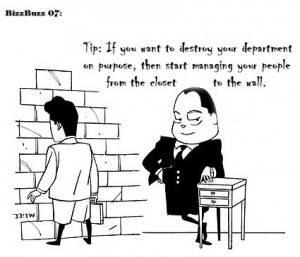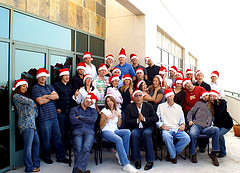|
|
|
Wednesday, September 10th, 2014

In addition to online media, videos and podcasts, there are literally miles of books detailing how best to lead and manage.
Many provide excellent information, while some are pure bulls**t.
One simple fact provides good guidance to bosses at all levels.
If you are an intelligent, talented, aggressive, competent boss, then manage others as you want to be managed.
This typically means well-defined goals, complete information, the authority necessary to successfully complete the work and clear, open communication,
However, the instant the boss moves towards less communication the result is usually more oversight.
Continue down that path and you’ll find yourself in the land of micromanagement.
Enter at your own risk and with a willingness to spend more time hiring.
Flickr image credit: maurice.heuts
Posted in Communication, Personal Growth | No Comments »
Monday, September 8th, 2014

What makes a great boss?
What traits do they have in common?
Obviously, great bosses are
- excellent communicators
- good at hiring,
- superb motivators,
- world-class team-builders, and
- caring mentors
Beyond those basics, with almost no exceptions, all are egalitarians.
That basic MAP trait permeates their actions and is apparent in their communications.
Great bosses, no matter the level of interaction, speak and act with the same respect, interest, appreciation, and consideration that they would want in similar circumstances.
Flickr image credit: Celestine Chua
Posted in Communication, Personal Growth | No Comments »
Tuesday, September 2nd, 2014

Conscious decisions made as the result of real conversations lead to better outcomes.
It doesn’t matter if it’s a boss and worker, colleagues, friends, parent and child, romantic liaison, or a marriage.
Relationships are the result of two people interacting together.
Relationships can be over in an instant or last a lifetime, but those that last longest have one thing in common.
Communication.
Decisions are founded on the ability to communicate
Call it the difference between just happening and intentional decisions.
New research shows that how thoughtfully couples make decisions can have a lasting effect on the quality of their romantic relationships. (…) “Making decisions and talking things through with partners is important,” said Galena K. Rhoades, a relationship researcher at the University of Denver and co-author of the report. “When you make an intentional decision, you are more likely to follow through on that.”
Although the research described in the article is focused on marriages, it can be applied just as well to the workplace.
In short, creating strong relationships, at work or away, requires the kind of good communications that lead to intentional decisions.
And it all starts by knowing yourself.
“At the individual level, know who you are and what you are about, and make decisions when it counts rather than letting things slide,” Dr. Stanley said. “Once you are a couple, do the same thing in terms of how you approach major transitions in your relationship.”
Try it; I believe you’ll find that the results make it worth the time and effort.
Flickr image credit: Katy Ereira
Posted in Communication, Ducks In A Row | No Comments »
Wednesday, June 25th, 2014
Every so often I see an ad campaign that I find truly impressive; when I do I like to share them with you.
One of the best was the initial ad for a very old product, tampons, sold in a brand new way, subscription, and perfectly focused on new (in every sense) customers.
Even the product name, Hello Flo, evokes laughter.
The first ad was hilarious and the follow up is even better.
I have others worth sharing and will do so on and off on future Wednesdays.
Image credit: Hello Flo
Posted in Communication, Innovation, Marketing | No Comments »
Thursday, June 12th, 2014
 One of the biggest problems I run into when I work with startups is what I call “familiarity blindness.” One of the biggest problems I run into when I work with startups is what I call “familiarity blindness.”
I see it most frequently in the content I am asked to revamp, but also occasionally in the products/services themselves.
Familiarity blindness is the result of being immersed in an idea at its most basic level from conception on and the result is often a version of not seeing the forest for the trees.
Typically, tech entrepreneurs are in love with their tech. They love to talk about it and it often forms the basis for discussion with their peers.
What tech entrepreneurs often have trouble accepting is that most customers don’t care.
That’s why it’s so important to know how your product/service is actually viewed by your market and that means getting out of the incubator or coffee house into the real world and talking to your target audience—not just talking, but really listening to what they say. (See yesterday’s post for help identifying and understanding your value proposition.)
When it comes to content, for your website, ads, articles, etc., “less is definitely more.”
Skip the technology, no matter how cool or groundbreaking, or even what it does, unless you are talking about what it does for your users/customers.
The exceptions are articles and interviews with technical media and even then what it does is usually more important than the technical description of how it does it.
Generally speaking, the only thing your potential users/customers care about is how your product/service will benefit them.
And they want to know quickly and painlessly and to understand with little mental effort on their part required.
Join me tomorrow for a look at familiarity blindness when pitching.
Flickr image credit:
Posted in Communication, Entrepreneurs | No Comments »
Tuesday, June 3rd, 2014
 When you want your people to do, or not do, something how do you approach the topic? When you want your people to do, or not do, something how do you approach the topic?
- Plead
- Make statements
- Pronounce edicts
- Create policy
- Threaten as in ‘or else’
When presenting, selling or just speaking are you serious, passionate, off-the-cuff or pragmatic?
No matter your approach, learning the principals of comedy will improve the results.
…skills that all good comedians know—such as storytelling, reading nonverbal cues, engaging an audience, dealing with hostility and silence, and more.
When I was a recruiter I always started my cold calls with the same words—“Hi, I’m Miki Saxon and I’m a headhunter;” they always laughed and when someone laughs you know they are listening.
Like this sign, humor gets more attention than threats, a more positive reaction and better compliance.

Humor can pierce attitudes and pry open minds.
Using humor isn’t about telling jokes; it’s about finding lighter ways to engage your audience even when the subject is serious.
Few people would find the death of the groom during sex on his wedding night to be funny, but if you remember Private Benjamin with Goldie Hawn it was hilarious.
Humor is in the delivery as opposed to the subject.
Best of all, using humor is not an inborn skill; anybody can learn how to do it.
Maybe not well enough to appear on Saturday Night Live, but well enough to motivate your team or close a sale.
Flickr image credits: Duck: Tambako The Jaguar; Sign: Angela Schmeidel Randall
Posted in Communication, Ducks In A Row | No Comments »
Monday, May 19th, 2014

Most everyone who is at all involved with tech is aware that Tom Preston-Werner, founder and former CEO of GitHub, resigned over harassment charges; the complaints included actions by his wife, Theresa Preston-Werner.
In short, people felt pressured by her to contribute time/energy/knowledge pro bono to her own startup.
While they were cleared in the investigation, Theresa posted an apology that included the following.
I was the wife of the CEO, but that never entered my mind when I hung out with any GitHubbers.
That blind spot was my mistake. In my enthusiasm over my project, and my idealistic belief in the status-free community of GitHub, I failed to recognize that power structures cannot ever be obscured entirely. It’s a powerful lesson, and a mistake I will not repeat.
What the Preston-Werners learned the hard way is that bosses aren’t like the rest of us and the higher you are on the totem pole the more weight your words carry.
The following post dates to 2006, but it’s just as true now as then and I seriously doubt it will change in the future.
For Bosses, No Such Thing as “Casual”
Bosses can’t make casual comments because nothing is casual when it’s coming from “the boss.” In fact, “casual comment” in juxtaposition with “boss” is positively oxymoronic!
This is especially true when the boss in question is the CEO/president/owner. Quick story:
A CEO, who started as an engineer, casually remarked to a group of designers that he didn’t think the circuit design they were doing would work.
He said this while taking a shortcut though the department, and with no in-depth knowledge of the project or previous discussions. Just an off-the-cuff comment based on his own design experience—which was a couple of decades old.
The design group then told the engineering VP that they needed to rethink the entire design because the CEO had said it wouldn’t work.
The engineering VP first convinced her team that the design was fine and to go ahead (not an easy sell); she then told her boss (the CEO) to quit talking to the engineers and stay out of the department, since this wasn’t the first time this had happened.
The CEO agreed, although he couldn’t understand the problem, all he’d made was a casual comment. Obviously, he couldn’t know as much as the design team since he’s been out of engineering for many years and they should have understood that.
Stories such as this happen in every industry, every day. The unusual parts here are that, one, the VP said something and, two, the CEO actually listened.
The no casual comment rule applies at all levels in any company. If you have leverage, your comments carry weight to those below you—the more leverage, the more weight.
I hope bosses everywhere take this to heart, since few underlings are comfortable telling the person who can fire them to, essentially, shut up.
Flickr image credit: GDS Productions
Posted in Personal Growth | No Comments »
Friday, April 25th, 2014
A Friday series exploring Startups and the people who make them go. Read all If the Shoe Fits posts here
 Yet again Sarah Milstein and her crew at Lean Startup have knocked it out of the ball park. The first time I experienced it was at their Lean Startup Conference last year. With the new Office Optional Conference, they have tapped into a motherload of issues that affect the Future of Knowledge Work and Workers. Companies both large and small are struggling with attracting, growing, retaining and managing distributed teams, just like an increasing portion of the workforce is enticed by the ability to work from home (or anywhere). Yet again Sarah Milstein and her crew at Lean Startup have knocked it out of the ball park. The first time I experienced it was at their Lean Startup Conference last year. With the new Office Optional Conference, they have tapped into a motherload of issues that affect the Future of Knowledge Work and Workers. Companies both large and small are struggling with attracting, growing, retaining and managing distributed teams, just like an increasing portion of the workforce is enticed by the ability to work from home (or anywhere).
I attended with Galina Landes who leads our engineering team, and one of the great experiences was to see how differently she and I experienced distributed work and strategies for improving what we’re doing. But then, engineers have always had a more logical approach to most things than those of us working in management or other functions in a company. Combining our perspectives and discussing strategies was interesting and very productive.
This conference on distributed teams dealt with collaboration, communication and the tools necessary for achieving goals as a team and creating a positive work environment. I’ve personally struggled with this in my previous company and now as we are building a new one. Our small team is fully distributed, although several of us are in the San Francisco Bay Area and can meet face to face when necessary. But it’s still challenging to build a company culture, have good communication and trust without which we can’t achieve our strategic goals.
Personally, I got a lot of ideas for tools and strategies to enhance our collaboration and communication. In addition, many of the speakers spoke about the need to create an environment where “water cooler talk” and informal communication (and interruptions) was acceptable. Just like in a normal office environment. After all, we human beings are (mostly) social creatures and need to create bonds and trust with those with whom we work to achieve goals.
It was a pleasure to see that so many people from large organizations such as GE to small startups like EMANIO, and everything in-between, dealing with the issues around an increasingly distributed workforce. In interacting with fellow participants, it was clear that we were all neophytes in the area and even those organizations that successfully had deployed a distributed model were still learning and adjusting their strategies and methods. Office Optional was a great learning experience and I’d exhort anyone dealing with these issues to participate next time they put it on. It was invaluable for us.
My only negative feedback would be that toward the latter part, the speakers became a bit repetitive. However, for a first conference small issues like this should be expected and judging from my prior experience with the Lean Startup team the next one will excellent.
The day ended with a conversation between Eric Ries, who wrote The Lean Startup, and Stanford’s Bob Sutton, who penned the No Asshole Rule, and more recently, Scaling Up Excellence. Though the conference would have been very good on its own, this was the crowning part of my experience. Professor Sutton is an engaged and charismatic speaker with deep knowledge of how organizations work. Excellence is what we’re all striving for and he provided a captivating roadmap for how to achieve it.
Image credit: HikingArtist
Posted in If the Shoe Fits | No Comments »
Monday, April 7th, 2014

How do you start your day?
Do your colleagues and boss jump on you with questions, demands and complaints?
Or are there congenial greetings, happy how-are-yous and questions displaying authentic interest in you-the-person?
Other than perpetual curmudgeons and people who got up on the wrong side of the bed, most people would prefer the second scenario to the first.
Bosses should take note, because the second scenario leads to higher productivity and better retention rates.
Wharton management professor Sigal Barsade has solid research to back that up, but, in my view, she badly undermined its adoption by choosing to describe it in terms that will turn off most managers.
She calls it “companionate love.”
Companionate love is shown “when colleagues who are together day in and day out, ask and care about each other’s work and even non-work issues. They are careful of each other’s feelings. They show compassion when things don’t go well. And they also show affection and caring — and that can be about bringing somebody a cup of coffee when you go get your own, or just listening when a co-worker needs to talk.”
Why don’t experts, especially academic experts get it? Why is it so difficult to understand that what something is called affects it in the marketplace?
From about age two on (maybe even younger) humans react to what something is called, whether a product or an action, and that reaction is a good predictor of success.
In today’s world, to succeed, management advice needs to develop terms that wrap the user in a mantle of cool while projecting an image of knowledge and leadership.
Sadly, ‘companionate love’ seems to fall short.
But that doesn’t mean you can’t implement the underlying philosophy or respect, consideration and interest using terms more acceptable to your situation.
Flickr image credit: jon oropeza
Posted in Communication, Culture, Personal Growth | No Comments »
Wednesday, March 12th, 2014
 It’s well known that what goes up comes down; programmers know that ‘garbage in/garbage out’ always holds true (and applies to more than programming, but that’s another post) and bosses (should) know that at some point current employees become former employees. It’s well known that what goes up comes down; programmers know that ‘garbage in/garbage out’ always holds true (and applies to more than programming, but that’s another post) and bosses (should) know that at some point current employees become former employees.
While people leave because of layoffs, it’s often by choice; either way it’s bad news and, like all bad news, requires clear communications to avoid repercussions.
However, there’s one repercussion that even the best communications can’t avoid and that’s what I call boss/company stupidity or BCS.
Granted, there’s a lot of BCS floating around the workplace, but this particular BCS ranks in the top three.
It’s the attitude that no matter how great employees are when they leave they are suddenly no good, their time with the company had no value and the resources invested in their growth were wasted.
The traditional way of looking at the “return on investment” on the training and coaching of employees is that it is truncated the moment they walk out of that door.
Which is really, really stupid.
Stupid because both companies and bosses have street reputations and while current employees contribute to them, those who leave have an outsize impact that lives everywhere forever in our social, wired world.
Flickr image credit: library_mistress
Posted in Communication, Motivation, Retention | No Comments »
|
 Subscribe to
Subscribe to
MAPping Company Success
About Miki 
Clarify your exec summary, website, etc.
Have a quick question or just want to chat? Feel free to write or call me at 360.335.8054
The 12 Ingredients of a Fillable Req
CheatSheet for InterviewERS
CheatSheet for InterviewEEs™
Give your mind a rest. Here are 4 quick ways to get rid of kinks, break a logjam or juice your creativity!
Creative mousing
Bubblewrap!
Animal innovation
Brain teaser
The latest disaster is here at home; donate to the East Coast recovery efforts now!
Text REDCROSS to 90999 to make a $10 donation or call 00.733.2767. $10 really really does make a difference and you'll never miss it.
And always donate what you can whenever you can
The following accept cash and in-kind donations: Doctors Without Borders, UNICEF, Red Cross, World Food Program, Save the Children
*/
?>About Miki
About KG
Clarify your exec summary, website, marketing collateral, etc.
Have a question or just want to chat @ no cost? Feel free to write
Download useful assistance now.
Entrepreneurs face difficulties that are hard for most people to imagine, let alone understand. You can find anonymous help and connections that do understand at 7 cups of tea.
Crises never end.
$10 really does make a difference and you’ll never miss it,
while $10 a month has exponential power.
Always donate what you can whenever you can.
The following accept cash and in-kind donations:
|







 One of the biggest problems I run into when I work with startups is what I call “familiarity blindness.”
One of the biggest problems I run into when I work with startups is what I call “familiarity blindness.” When you want your people to do, or not do, something how do you approach the topic?
When you want your people to do, or not do, something how do you approach the topic?

 Yet again Sarah Milstein and her crew at Lean Startup have knocked it out of the ball park. The first time I experienced it was at their Lean Startup Conference last year. With the new
Yet again Sarah Milstein and her crew at Lean Startup have knocked it out of the ball park. The first time I experienced it was at their Lean Startup Conference last year. With the new 
 It’s well known that what goes up comes down; programmers know that ‘garbage in/garbage out’ always holds true (and applies to more than programming, but that’s another post) and bosses (should) know that at some point current employees become former employees.
It’s well known that what goes up comes down; programmers know that ‘garbage in/garbage out’ always holds true (and applies to more than programming, but that’s another post) and bosses (should) know that at some point current employees become former employees.
